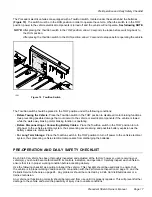
Pre-Operation and Daily Safety Checklist
•
General:
All the parts should be in place and properly installed. Be sure that all nuts, bolts, and screws are tight.
•
Safety and information decals:
Check to ensure that all safety and information decals are in place.
See Safety
Decal and Feature Identification on page 4.
•
Tires:
Check for proper tire pressure. Visually inspect tires for wear, damage, and proper inflation on a daily basis.
See Vehicle Specifications on page 35.
•
Performance Inspection:
Inspect as instructed.
See Performance Inspection on page 18.
•
Batteries:
Check electrolyte to ensure that it is at its proper level
(Figure 12, Page 30)
. Check battery posts. Wires
should be tight and free of corrosion. Charge batteries fully before first use of vehicle.
•
Charger cord, plug, and receptacle:
Visually inspect for cracks, loose connections, and frayed wiring.
See Plug
and Receptacle in the owner’s manual supplied with the battery charger.
PERFORMANCE INSPECTION
After you have familiarized yourself with the vehicle controls and have read and understood the driving instructions,
take the vehicle for a test drive.
Use the following checklist in conjunction with the Daily Pre-Operation and Safety Checklist as a guide to inspect the
vehicle and check daily for proper operation. Any problems should be corrected by a Club Car distributor/dealer or a
trained technician.
•
Forward/Reverse switch:
Check for proper operation.
See Controls and Indicators – Electric Vehicles on
page 13.
•
Brakes:
Be sure the brakes function properly. When brake pedal is pressed using moderate pressure, the
vehicle should come to a smooth, straight stop. If the vehicle swerves or fails to stop, stops abruptly, or makes
a grinding or squeaking noise, have the brake system checked and adjusted as required. Continued, moderate
brake pedal pressure should be able to lock the wheels, but using lesser pressure should also permit a slow,
gradual deceleration.
•
Park brake:
When latched, the park brake should lock the wheels and hold the vehicle stationary (on an incline of
20% or less). It should release when either the accelerator or brake pedal is pressed.
•
Reverse buzzer:
The reverse buzzer will sound as a warning when the Forward/Reverse handle or switch is in
the REVERSE position.
•
Steering:
The vehicle should be easy to steer and should not have any play in the steering wheel.
•
General:
Listen for any unusual noises such as squeaks or rattles. Check the vehicle’s ride and performance.
Have a Club Car distributor/dealer or a trained technician investigate anything unusual.
•
Accelerator:
With the key switch in the ON position and the Forward/Reverse switch in the FORWARD position, as
the accelerator pedal is pressed, the motor should start and the vehicle should accelerate smoothly to full speed.
When the pedal is released it should return to the original position. All Club Car vehicles operate at reduced
speed in reverse.
•
Walk Away Braking:
With the vehicle parked on level ground and the park brake disengaged, place the Tow/Run
switch in the RUN position and attempt to push the vehicle. Motor braking should engage and cause resistance to
rolling (moving at no more than 1 to 3 mph) (1.5 to 4.8 km/h) with the Forward/Reverse switch in any position.
When walk away motor braking is engaged, the reverse buzzer should emit a distinct pattern of beeps.
See
following WARNING.
WARNING
• Walk Away Braking will not limit vehicle speed to 1 mph (1.6 km/h) on very steep grades. Do not
operate vehicle on slopes exceeding 20% grades.
Page 18
Precedent Stretch Owner’s Manual
Summary of Contents for Precedent Stretch
Page 1: ...Precedent Stretch Owner s Manual Electric Refer to back cover for applicable build code range...
Page 2: ......
Page 39: ...Warranty WARRANTY TBD Precedent Stretch Owner s Manual Page 37...
Page 40: ......
Page 42: ......
Page 43: ......
Page 44: ......
Page 45: ...Club Car R NOTES...
Page 46: ......
Page 47: ......






























